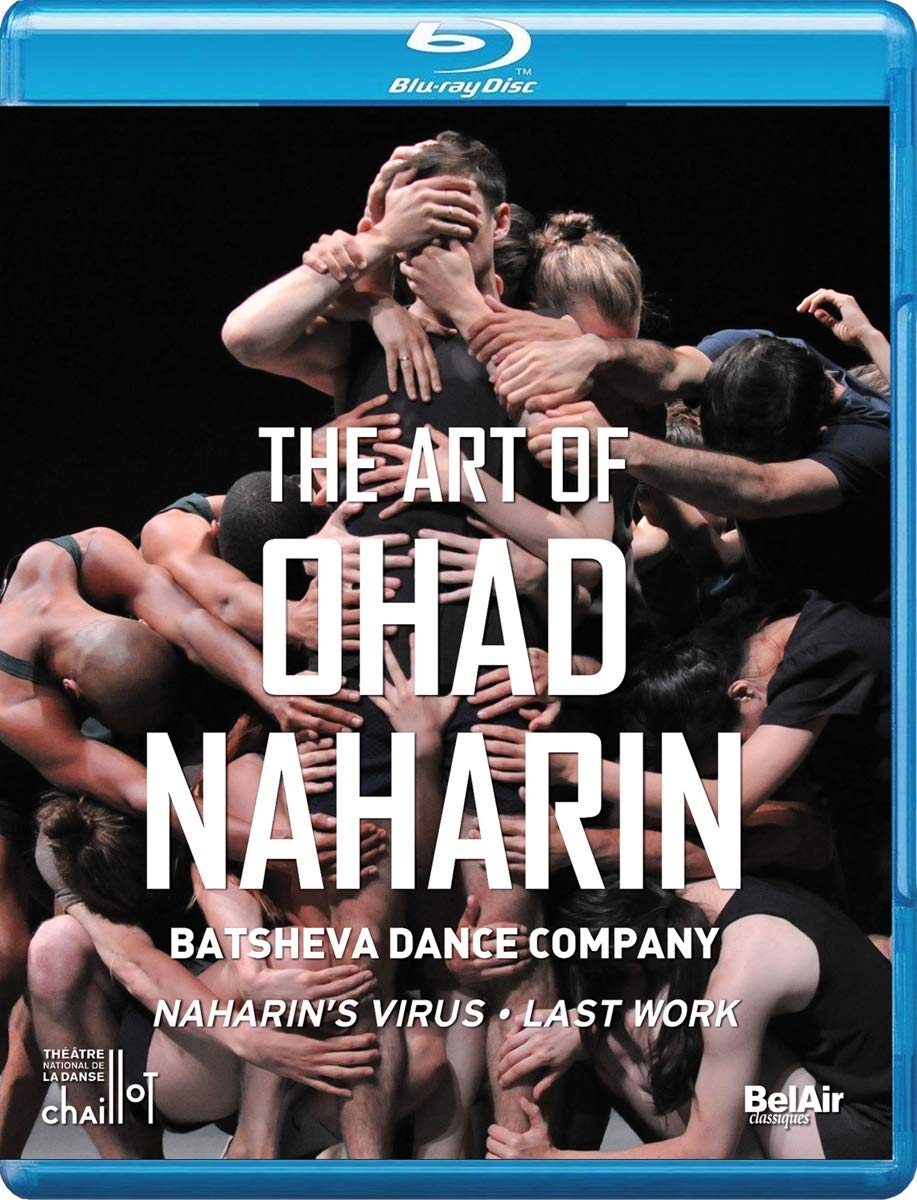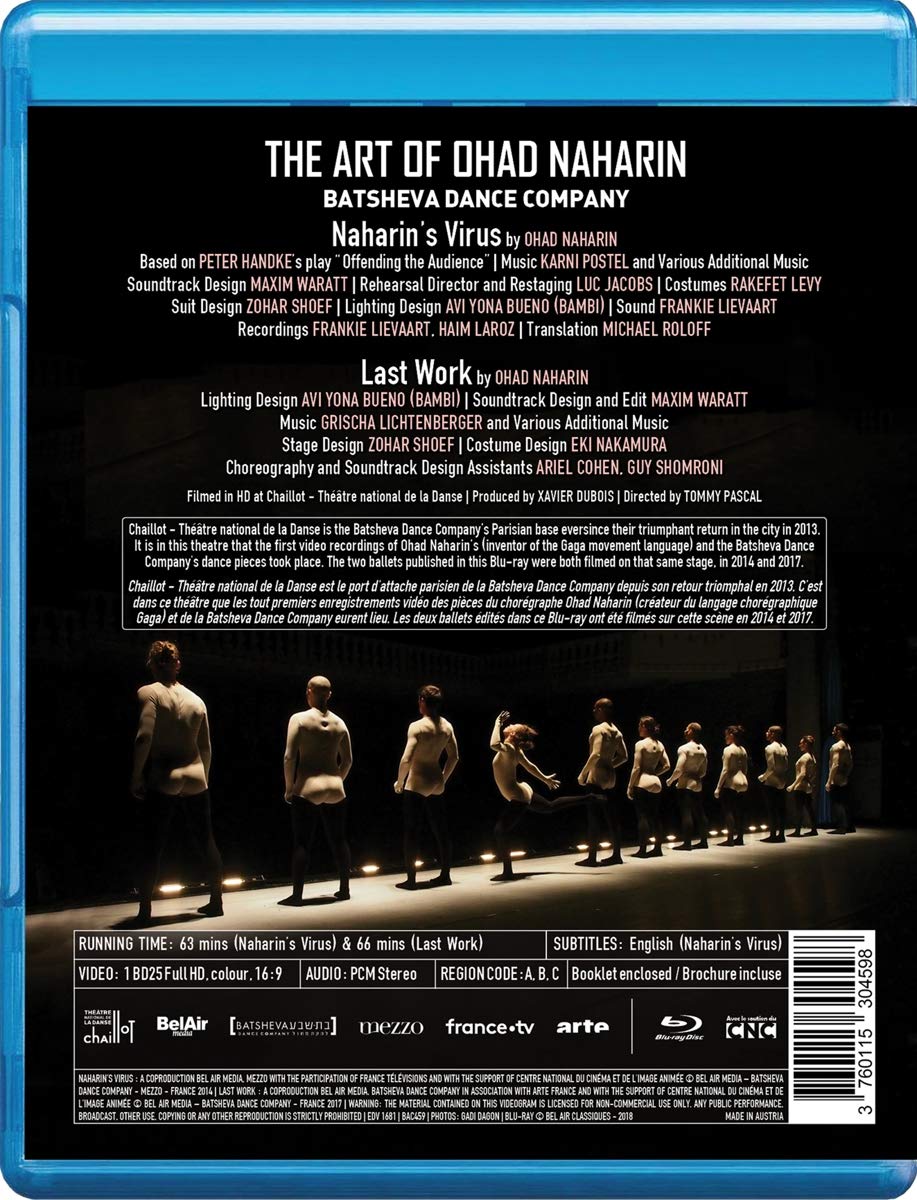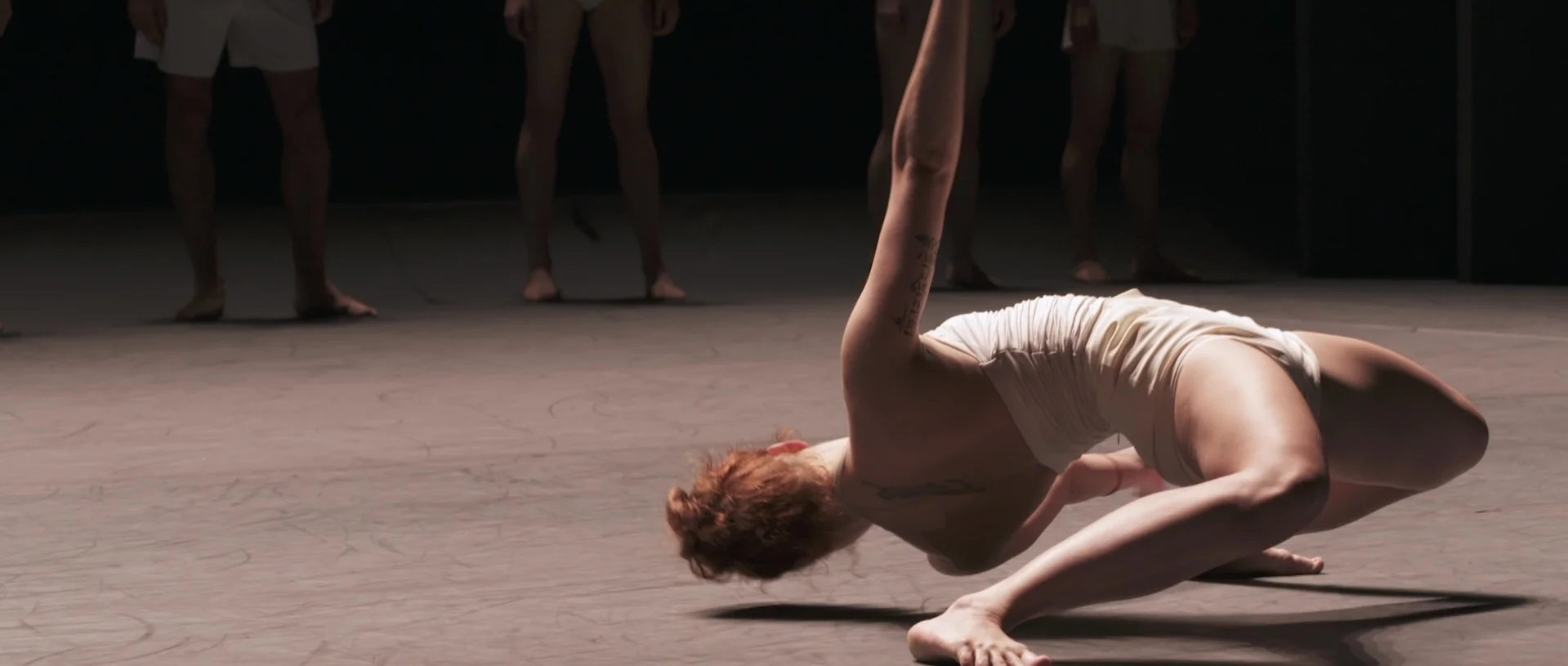

The Art of Ohad Naharin dance double bill choreographed by Ohad Naharin. Performed 2014 and 2017 by the Batsheva Dance Company on the same stage at the Chaillot-Théâtre national de la Danse in Paris. Disc includes:
Naharin’s Virus from 2001 and revived 2014. Restaged and directed by Luc Jacobs. Dancers: William Barry, Omri Drumlevich, Bret Easterling, Iyar Elezra, Rani Ledzelter, Eri Nakamura, Rachael Osborne, Shamel Pitts, Oscar Ramos, Nitzan Ressler, Ian Robinson, Or Meir Schraiber, Maayan Sheinfeld, Bobbi Jene Smith, Zina (Natalia) Zinchenko, and Adi Zlatin. Original music by Karni Postel with additional music from Samuel Barber (Adagio performed by Kronos Quartet), Carlos D`Allessio (Les bulles), P. Stokes & P. Parsons (I want performed by Breakbeat Massive), and traditional Arab folk music by Al Majad group. Costumes by Rakefet Levy; suit design by Zohar Shoef; lighting design by Avi Yona Bueno (Bambi); sound by Frankie Lievaart; sound recordings by Frankie Lievaart and Haim Laroz. Narration in French for the Paris audience. Subtitles in English only with translations from original German text by Michael Roloff.
Last Work from 2015 with choreography assistance by Ariel Cohen. Dancers: William Barry, Yael Ben Ezer, Matan Cohen, Omri Drumlevich, Bret Easterling, Hsin-yi Hsiang, Chunwoong Kim, Rani Lebzelter, Eri Nakamura, Ori Moshe Ofri, Nitzan Ressler, Or Meir Schreiber, Maayan Sheinfeld, Yoni (Yonatan) Simon, Amalia Smith, Bobbi Jene Smith, and Zina (Natalia) Zinchenko. Original music by Grischa Lichtenberger; additional music by Sagat (Few Mysteries Solved in a Year of Contact), Hysterics (Club Life), MPIA3 (Crusty Juice), Monkeys (Volume VIP), Luminox (Tantrum); Lullabies-of-Europe (Nani, Nani, Mummies Baby and Nani, Nani, My Sweet Little Baby); and Clara Rockmore (Berceuse); lighting by Avi Yona Bueno (Bambi); soundtrack design assisted by Guy Shomroni; stage design by Zohar Shoef; costume design by Eki Nakamura.
For both productions: Soundtrack design by Maxim Waratt (a pseudenym for Ohad Naharin); video files directed for TV by Tommy Pascal; produced by Xavier Dubois. Released 2019, disc has 2.0 stereo sound. Grade: A
Naharin is one of the most innovative and influential choreographers of our time. He has made at least 46 major modern dance works which we have listed for you in a special memo. In the 1990s he gradually developed the famous Gaga movement language (when Lady Gaga was still growing up) now used in professional modern dance and also by non-dancing folks for fun and therapeutic exercise. In 2017 Tomer Heymann released Mr. Gaga, a documentary in DVD about Naharin and his work. This is perhaps the best documentary about dance ever made. Mr. Gaga was later released in Blu-ray, but that title has not been widely distributed as of March 2019. (Mr. Gaga will not be reviewed on this website because it consists mostly of legacy material).
The Art of Ohad Naharin is the first recording of Naharin choreography published in Blu-ray. Both Naharin’s Virus and Last Work are unusually long (over a hour each) for abstract modern dance pieces. Naharin’s Virus, probably Naharin’s most famous work, is atypical in that it has a highly intellectual structure based on a famous experimental theater play. Last Work (not actually Naharin’s last creation) would seem to be a completely original magnum opus fully infused with Gaga techniques. (In the past, we excluded dance titles with stereo sound only. This proved to be a mistake in respect to modern dance. Most modern dance productions use recorded rather than live music. So a good stereo soundtrack is all that can reasonably expected on a Blu-ray video of a modern work when there is no live music.)
Naharin’s Virus
Naharin’s Virus is based on Peter Handke’s German-language experimental theater play Publikumbeschimpfung from 1966. This jaw-breaking German word is usually translated into English as “Insulting the Audience” or “Offending the Audience.” Per Wikipedia, Handke said in 1970 “The idea was to have the spectators . . . thrown back upon themselves. My theatrical plan is to have the audience always look upon my play as a means of testing other plays. “ It appears the words spoken to the audience in Naharin’s Virus all come from Handke’s text (translated into English). We don’t know the play, but it would appear that the structure of Naharin’s Virus faithfully follows Handke’s conception while using much (or perhaps all) of the theater text.
By borrowing so heavily from Handke, Naharin tries to convince his audience to look upon the Gaga-inspired Naharin’s Virus as a means of testing or judging other dancing. There would be no way to get this abstract idea across through physical motions of the dancers’ bodies alone.
Sorry about all this theory. Let’s do some screenshots. The stage is utterly bare but with a huge “blackboard” across the entire rear of the stage. The essence of every Gaga show consists of (1) surprising theatrical originality (similar to Pina Bausch) coupled with (2) dancers trained to establish deep emotional connections to the audience with their Gaga movement techniques. (Of course, many choreographers ask their dancers to emote, but Naharin tries harder in a way that reminds us of Alonzo King’s concept of the “human masterpiece.” ) Within a few seconds after the music starts, we see all of this. How many times before have you seen dancers fill a giant blackboard with chalk art? Never! And does this dancer at the blackboard remind you of your 5th grade teacher? No. When you see all the moves this lady has you will not be thinking of algebra or history. And as her spectacle unfolds you hear a plangent voice saying, “You will see no spectacle.” Welcome to Gaga:
Next below all the dancers are on the stage in their snappy nude-suits. (Naharin usually dresses his dancers eclectically, but the rigid didactic emphasis of this piece calls for a sophisticated uniform.) In the next image below, the “teacher” is drawing on the opposite and empty wall as the narrator (standing on top of the blackboard) insists that the center of interest is the audience and not the dancers:
The word on the blackboard is a scrambled misspelling of “Palestine.” Naharin is a well-known critic of the current treatment of the Palestinians by the government of Israel:
The emphasis shifts unexpectedly from big-picture concepts to intimate personal feelings:
Or the choreographer calls for quirky physical stunts:
Or chilling moments of mysterious introspection:
Or existentialist philosophy?
A pas de deux with red chalk:
And at the end, the audience is dramatically whip-sawed:
Every great dance piece starts with great music, and Naharin is a master at coming up with arresting music (all played from recordings) to match his dance conceptions. The dancers are masters of counting and remembering simultaneous moves in ensemble mode as well as improvising. Everyone is operating in a universe parallel to the 5-position approach of the classical ballet companies with all the French steps, stories, plots, scenery, props, and women on point. And Virus is rare in the entire history of dance in that it manages to give the audience, in addition to sights to behold, wave on wave of things to think about.
The intellectual and artistic quality of the Virus choreography is heaven high. The dancers show incredible discipline in the ensembles as well as startling versatility in individual interpretations. The video images are clear, sharp, and well composed with only slight motion blur. The sound recordings are great with good detail and punch. But what about video content? We did a ballet wonk worksheet. Alas, the video pace is a too-fast 7 seconds per clip. But on the other hand, we are pleased that 75% of Tommy Pascal’s clips show the whole bodies of the dancers. Under our standards for video content we must diagnose a distinct case of DVDitis. (See our special article to learn more about DVDitis in general. To learn more about how we judge DVDitis in dance titles, see our special article on the best Blu-ray dance titles.) We wind up reducing the potential A+ grade for Naharin’s Virus to A-.
Last Work
Last Work is Naharin’s magnum opus of pure Gaga splendor. There’s plenty of theatrical originality, but the sole purpose of the dance is to inflame the audience through sympathetic vibrations with emotions the dancers display. In the first image below we see the theatrical trick of the girl on the treadmill. With her running she beats out the rhythm of an excited heart — the emotional metronome for the whole show. And we see here half the dancers cuddling. The world of dance is as cut-throat as any human activity that exists, but they do seem to love each other, don’t they!
In the first half of the show, the dancers mostly wear black. In the next image below, the whole cast changes on stage to the mostly white they will wear in the second half (except, of course, for the heartbeat girl in blue). But who is the one man squatting? Well, one of Naharin’s favorite tricks is to form masses of dancers in ensemble, but almost always there is at least one dancer who falls out as a human punctuation mark):
The Batsheva Company is small and there is a lot of turn-over. Only 10 dancers appear in both Virus and Last Work. Of the 17 dancers in Last Work, only 9 were still in the company in 2019. The women especially tend to look alike. We gave up on trying to identify the dancers by name for fear we would make too many mistakes. But we will identify the soloist in the next screenshot below — she is Eri Nakamura, the wife of Ohad Naharin and the mother of his only child. She also did the costumes in Last Work:
The next two shots feature the same red-headed woman who is extraordinarily flexible. After doing the split, she can locomote across the stage without raising any part of her body from the floor:
And she can rise to standing from the position below with only her feet touching:
Next below we see shots of 3 duets:
And here is a men’s trio performing against an array on the floor:
The trio becomes a quartet:
And below a mixed quartet:
Naharin makes amazing use of rows and various arrays:
Surprise: a tutu — maybe the only tutu ever in a Naharin project?
Headmasks!
Below our favorite shot from Last Work and currently the wallpaper on our PCs:
The shot above morphs into the formation below — fun to watch:
Any object from everyday life can become a prop for Naharin. Yes, the image below is full of plastic package wrapping tape:
The first dancer to take a bow is the lady on the treadmill:
All the good things we said above about the Virus video apply also to Last Work. And we also did a wonk worksheet for Last Work. We were happily surprised that the video content of Tommy Pascal’s second recording is superb! Instead of a too-fast pace of 7 seconds per clip, Pascal put on the brakes and came up with a commendable pace of 13 seconds per clip. Perhaps this better pace is attributable to the slower pace of the music and greater emphasis on individual dancers in Last Work. But we also suspect that Pascal may have been unhappy with the pace on Virus and deliberately slowed down his second recording to get a better product. In any event, there’s nothing but good to be said about Last Work, and it gets an A+.
BelAir has come up with a winner in The Art of Ohad Naharin. For originality, dance execution, arresting music, and museum-art-grade photography, we rank this with such classics as the McGregor Triple Bill (Chroma/Infra/Limen), the Édouard Lock Amelia, and C(H)ŒURS from les ballets C de la B. We give a blended grade of A to the title and will put it on our list of best dance recordings. But the DVDitis in Virus will deny this title the 💓 designation.
OR































